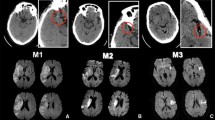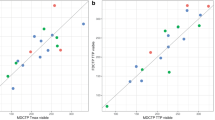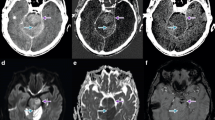Abstract
Single-photon emission tomography (SPET) is widely used in the investigation of acute stroke. We investigated the relationship between SPET data and functional outcome in a large group of acute stroke patients. One hundred and eight patients underwent cerebral computed tomography (CT) and technetium-99m hexamethylpropylene amine oxime SPET after acute ischaemic stroke. We categorised the clinical presentation according to the Oxford classification of acute stroke. Outcome was measured 1 year after stroke using mortality and the Barthel Index for survivors. SPET scans were interpreted without reference to the clinical data using a semi-automatic technique. Three experienced observers determined the presence of luxury perfusion using suitably scaled SPET images in conjunction with the CT scan. Both SPET volume and severity of deficit were significantly negatively correlated with Barthel Index at 1 year (r s=−0.310,P<0.0001, andr s=−0.316,P<0.0001 respectively). In patients scanned with SPET within 16 h of stroke onset, the correlations were more strongly negative (r s=−0.606,P<0.0001, andr s=−0.492,P<0.005 respectively). Luxury perfusion was not associated (χ 2=0.073,df=1,P=0.79) with good functional outcome (Barthel score ≥60). Stepwise logistic regression identified Oxford classification, total deficit volume and patient's age as significant predictors of functional outcome. Overall predictive accuracy was 72%. Predictive accuracy was better in patients who received SPET within 16 h of stroke onset. SPET provides useful information about the functional outcome of acute stroke at 1 year. However, the accuracy of prediction decreases the longer SPET is delayed. Prognostication using SPET in combination with clinical assessment and other investigations may also be considered.
Similar content being viewed by others
References
Bryan RN, Levy LM, Whitlow WD, Killian JM, Preziosi TJ, Rosario JA. Diagnosis of acute cerebral infarction — comparison of CT and MR imaging.Am J Neuroradiol 1991; 12: 611–620.
Von Kummer R, Meyding-Lamade U, Forsting M, et al. Sensitivity and prognostic value of early CT in occlusion of the middle cerebral artery trunk.Am J Neuroradiol 1994; 15: 9–15.
Holman BL, Devous MD. Functional brain SPECT: the emergence of a powerful clinical method.J Nucl Med 1992; 33: 1888–1904.
Fayad PB, Brass LM. Single photon computed tomography in cerebrovascular disease.Stroke 1991; 22: 950–954.
Bullock R, Patterson J, Park C. Evaluation of99mTc-hexamethylpropyleneamine oxime cerebral blood flow mapping after focal ischaemia in rats.Stroke 1991; 22: 1284–1290.
Heiss W, Zeiler K, Havelec L, Reisner T, Bruck J. Long-term prognosis in stroke related to cerebral blood flow.Arch Neurol 1977; 34: 671–676.
Kushner M, Reivich M, Fieschi C, et al. Metabolic and clinical correlates of acute ischemic infarction.Neurology 1987; 37: 1103–1110.
Lee RGL, Hill TC, Holman BL, Royal HD, O'Leary DH, Clouse ME. Predictive value of perfusion deficit size usingN-isopropyl-(I-123)-p-iodoamphetamine emission tomography in acute stroke.J Neurosurg 1984; 61: 449–452.
Mountz JM, Modell JG, Foster NL, et al. Prognostication of recovery following stroke using the comparison of CT and technetium 99m HM-PAO SPECT.J Nucl Med 1990; 31: 61–66.
Limburg M, van Royen EA, Hijdra A, Verbeeten BWJ. rCBFSPECT in brain infarction: when does it predict outcome?J Nucl Med 1991; 32: 382–387.
Giubilei F, Lenzi GL, DiPiero V, et al. Predictive value of brain perfusion SPECT in acute ischaemic stroke.Stroke 1990; 21: 895–900.
Hanson SK, Grotta JC, Rhoades H, et al. Value of single-photon emission computed tomography in acute stroke therapeutic trials.Stroke 1993; 24: 1322–1329.
Davis SM, Chua MG, Lichtenstein M, Rossiter SC, Binns D, Hopper JL. Cerebral hypoperfusion in stroke prognosis and brain recovery.Stroke 1993; 24: 1691–1696.
Alexandrov AV, Bladin CF, Ehrlich LE, Norris JW. Value of TCD and SPECT in acute ischemic stroke.Neurology 1993; 43: A201.
Limburg M, van Royen EA, Hijdra A, de Bruine JF, Verbeeten BWJ. Single-photon emission computed tomography and early death in acute ischaemic stroke.Stroke 1990; 21: 1150–1155.
Laloux P, Richelle F, Jamart J, De Coster P, Laterre C. Comparative correlation of HMPAO SPECT indices, neurological score, and stroke subtypes with clinical outcome in acute carotid infarcts.Stroke 1995; 26: 816–821.
Infeld B, Davis SM, Lichtenstein M, Mitchell PJ, Hopper JL. Crossed cerebellar diaschisis and brain recovery after stroke.Stroke 1995; 26: 90–95.
Lassen NA. The luxury perfusion syndrome and its possible relation to acute metabolic acidosis localised within the brain.Lancet 1966; II: 1113–1115.
Hellman RS, Tikofsky RS. An overview of the contribution of regional cerebral blood flow studies in cerebrovascular disease: is there a role for single photon emission computed tomography?Semin Nucl Med 1990; 20: 303–324.
Irino T, Minami T, Taneda M, Hara K. Brain edema and angiographical hyperemia in postrecanalized cerebral infarction.Acta Neurol Scand 1977; 56: 134–135.
Jorgensen HS, Sperling B, Nakayama H, Raaschou HO, Olsen TS. Spontaneous reperfusion of cerebral infarcts in patients with acute stroke: incidence, time course, and clinical outcome in the Copenhagen Stroke Study.Arch Neurol 1994; 51: 865–873.
Bamford JM, Sandercock PAG, Dennis MS, Burn J, Warlow CP. Classification and natural-history of clinically identifiable subtypes of cerebral infarction.Lancet 1991; 337: 1521–1526.
Sperling B, Lassen NA. Hyperfixation of HMPAO in subacute ischemic stroke leading to spuriously high estimates of cerebral blood-flow by SPECT.Stroke 1993; 24: 193–194.
Steinling M, Huglo D, Kolesnikov H, Vergnes R, Rouseaux M. ‘Normal’ 99mTc-HMPAO distribution in large subacute middle cerebral artery infarct.Stroke 1994; 25: 2507–2508.
Mahoney FI, Barthel DW. Functional evaluation: Barthel Index.Maryland State Med J 1965; 14: 61–65.
Kendrick S, Clarke J. The Scottish record linkage system.Health Bull 1993; 51: 1–15.
Shinar D, Gross CR, Bronstein KS, et al. Reliability of the activities of daily living scale and its use in telephone interview.Arch Phys Med Rehabil 1987; 68: 723–728.
Trust Study Group. Randomised, double-blind, placebo-controlled trial of nimodipine in acute stroke.Lancet 1990; 336: 1205–1209.
Moretti JL, Defer G, Cinotti L, et al. Luxury perfusion with Tc-99m-HMPAO and I-123 IMP SPECT imaging during the subacute phase of stroke.Eur J Nucl Med 1990; 16: 17–22.
Gompertz P, Pound P, Ebrahim S. Predicting stroke outcome — Guy's prognostic score in practice.J Neurol Neurosurg Psychiatry 1994; 57: 932–935.
Allen CMC. Predicting the outcome of acute stroke: a prognostic score.J Neurol Neurosurg Psychiatry 1984; 47: 475–480.
Bowler JV, Wade JPH, Jones BE, Nijran K, Steiner TJ. Singlephoton emission computed tomography using hexamethylpropyleneamine oxime in the prognosis of acute cerebral infarction.Stroke 1996; 27: 82–86.
Author information
Authors and Affiliations
Rights and permissions
About this article
Cite this article
Weir, C.J., Bolster, A.A., Tytler, S. et al. Prognostic value of single-photon emission tomography in acute ischaemic stroke. Eur J Nucl Med 24, 21–26 (1997). https://doi.org/10.1007/BF01728304
Received:
Revised:
Issue Date:
DOI: https://doi.org/10.1007/BF01728304




